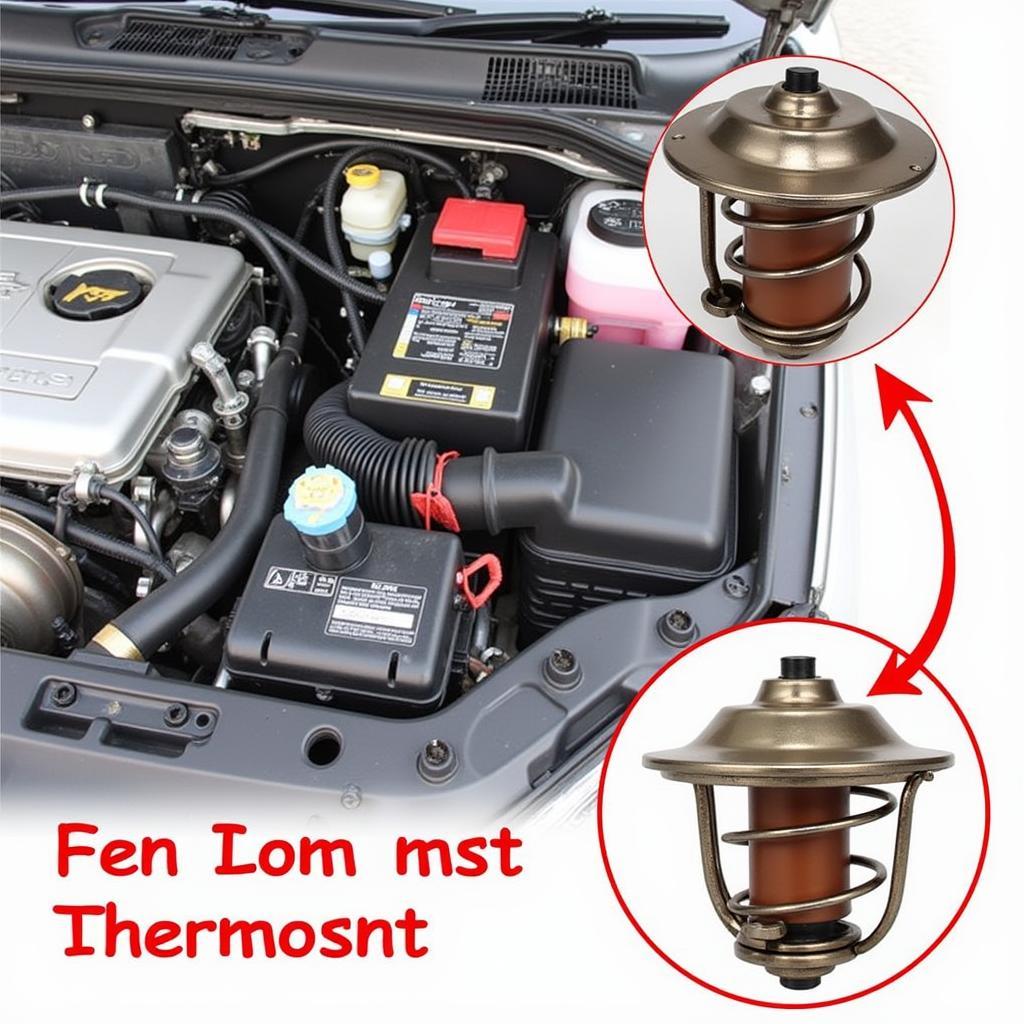Car Engine Thermostat Problems can lead to overheating, poor fuel economy, and even engine damage. Understanding how the thermostat works and how to diagnose and fix these problems is crucial for every car owner and mechanic. This guide will provide you with everything you need to know about car engine thermostat problems.
What is a Car Engine Thermostat and Why is it Important?
The thermostat is a small but vital component of your car’s cooling system. It regulates the flow of coolant to the engine, ensuring it reaches optimal operating temperature quickly and stays there. A malfunctioning thermostat can disrupt this process, leading to a variety of issues.
Common Car Engine Thermostat Problems
Several problems can arise with your car’s thermostat. These include:
- Stuck Open Thermostat: This prevents the engine from reaching its optimal operating temperature, leading to poor fuel economy and increased emissions. In colder climates, this can also make it difficult for the heater to produce enough heat.
- Stuck Closed Thermostat: This restricts coolant flow, causing the engine to overheat. Overheating can lead to severe engine damage, including warped cylinder heads and cracked engine blocks.
- Intermittent Thermostat Failure: This is the trickiest type of thermostat failure, as the symptoms can be unpredictable and difficult to diagnose. The thermostat may work correctly sometimes and malfunction at other times, causing fluctuating engine temperatures.
Diagnosing Car Engine Thermostat Problems
If you suspect a thermostat problem, there are several ways to diagnose it:
- Check the Temperature Gauge: A consistently low or high temperature reading on your car’s temperature gauge can indicate a thermostat problem.
- Feel the Upper and Lower Radiator Hoses: After the engine has warmed up, carefully touch the upper and lower radiator hoses. If the upper hose is hot and the lower hose is cold, it could indicate a stuck closed thermostat.
- Use an OBD-II Scanner: An OBD-II scanner can read diagnostic trouble codes (DTCs) related to the cooling system, including thermostat malfunctions.
 Car Engine Thermostat Location and Identification
Car Engine Thermostat Location and Identification
How to Fix Car Engine Thermostat Problems
In most cases, the only solution for a faulty thermostat is replacement. This is a relatively simple and inexpensive repair that can be done by a DIYer with basic mechanical skills. Here’s a general guide:
- Drain the Coolant: Locate the radiator drain petcock and drain the coolant into a clean container.
- Remove the Thermostat Housing: Locate the thermostat housing and remove the bolts that secure it.
- Replace the Thermostat: Remove the old thermostat and install the new one, ensuring it is properly seated.
- Reinstall the Thermostat Housing: Reinstall the thermostat housing and tighten the bolts.
- Refill the Coolant: Refill the cooling system with the correct type of coolant and bleed the system to remove any air pockets.
Similar to digital car water temperature gauge problems, a faulty thermostat can cause inaccurate temperature readings. This underscores the importance of a functioning thermostat for accurate temperature monitoring.
Preventing Car Engine Thermostat Problems
While thermostat failure is sometimes unavoidable, there are steps you can take to prolong its lifespan:
- Use the Correct Coolant: Always use the coolant recommended by your vehicle’s manufacturer.
- Flush the Cooling System Regularly: Flushing the cooling system helps remove contaminants that can damage the thermostat and other cooling system components. This is related to issues discussed in 2003 lincoln town car problems 4.6 liter replace water pump.
- Monitor the Temperature Gauge: Keep an eye on your car’s temperature gauge and address any unusual readings promptly. For instance, understanding heat temperature problems on a 2004 lincoln town car can be crucial in identifying potential thermostat issues.
For those experiencing car engine heat up problem, a faulty thermostat is a likely culprit. This link provides more insights into the causes and solutions for engine overheating. Furthermore, understanding how to diagnose car problems reviews can be helpful in identifying thermostat issues.
Conclusion
Car engine thermostat problems can range from minor inconveniences to major engine damage. Understanding how to diagnose and fix these problems is essential for keeping your car running smoothly. By following the tips outlined in this guide, you can identify and address thermostat issues before they become serious problems. Remember, regular maintenance and prompt attention to warning signs are key to preventing costly repairs. Connect with us at AutoTipPro at +1 (641) 206-8880 or visit our office at 500 N St Mary’s St, San Antonio, TX 78205, United States for expert assistance with your car engine thermostat problems.







Leave a Reply